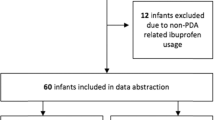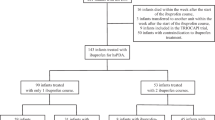Abstract
Background Data on the effectiveness of oral ibuprofen treatment for patent ductus arteriosus are limited, and the factors affecting its effectiveness remain unclear. Objective The aim was to identify the potential factors affecting the clinical effectiveness of oral ibuprofen in preterm infants. Setting Neonatal intensive care unit in a prefecture-level maternal and child healthcare hospital in China. Method Over a 5-years period, the medical records of 327 preterm infants with patent ductus arteriosus who were admitted to the neonatal intensive care unit of our hospital to receive a single course of oral ibuprofen were retrospectively reviewed. Main outcome measures The prevalence of risk factors affecting the effectiveness of oral ibuprofen. Results In total, 201 (61.47%) preterm infants were considered to have undergone “effective therapy” and classified accordingly, whereas 11 (3.36%) showed certain adverse events. Factors affecting therapeutic effectiveness were postnatal age at the initiation of treatment and Day 1/Day 0 ratio of urine output/fluid intake during the treatment course, with odds ratios of 0.892 (95% CI: 0.835–0.953; P = 0.001) and 0.473 (95% CI 0.265–0.845; P = 0.011), respectively. Conclusion A single course of oral ibuprofen for patent ductus arteriosus closure among preterm infants is effective and safe. Preterm infants with postnatal age of ≤ 9 days at the initiation of treatment and Day 1/Day 0 ratio of ≤ 0.708 of the urine output/fluid intake during the treatment course can be considered predictors of effectiveness of patent ductus arteriosus.


Similar content being viewed by others
References
Noori S, McCoy M, Friedlich P, Bright B, Gottipati V, Seri I, et al. Failure of ductus arteriosus closure is associated with increased mortality in preterm infants. Pediatrics. 2009;123(1):e138–44.
Ohlsson A, Walia R, Shah SS. Ibuprofen for the treatment of patent ductus arteriosus in preterm or low birth weight (or both) infants. Cochrane Database Syst Rev. 2020;2:CD003481.
Sivanandan S, Bali V, Soraisham AS, Harabor A, Kamaluddeen M. Effectiveness and safety of indomethacin versus ibuprofen for the treatment of patent ductus arteriosus in preterm infants. Am J Perinatol. 2013;30(9):745–50.
Kabra NS, Schmidt B, Roberts RS, Doyle LW, Papile L, Fanaroff A. Neurosensory impairment after surgical closure of patent ductus arteriosus in extremely low birth weight infants: results from the Trial of Indomethacin Prophylaxis in Preterms. J Pediatr. 2007;150(3):229–34.
Olgun H, Ceviz N, Kartal I, Caner I, Karacan M, Tastekin A, et al. Repeated courses of oral ibuprofen in premature infants with patent ductus arteriosus: efficacy and safety. Pediatr Neonatol. 2017;58(1):29–35.
Sung SI, Chang YS, Chun JY, Yoon SA, Yoo HS, Ahn SY, et al. Mandatory closure versus nonintervention for patent ductus arteriosus in very preterm infants. J Pediatr. 2016;177:66–71.
Clyman RI. The role of patent ductus arteriosus and its treatments in the development of bronchopulmonary dysplasia. Semin Perinatol. 2013;37(2):102–7.
Mirea L, Sankaran K, Seshia M, Ohlsson A, Allen AC, Aziz K, et al. Treatment of patent ductus arteriosus and neonatal mortality/morbidities: adjustment for treatment selection bias. J Pediatr. 2012;161(4):689–94.
Sehgal A, Paul E, Menahem S. Functional echocardiography in staging for ductal disease severity: role in predicting outcomes. Eur J Pediatr. 2013;172(2):179–84.
Chorne N, Leonard C, Piecuch R, Clyman RI. Patent ductus arteriosus and its treatment as risk factors for neonatal and neurodevelopmental morbidity. Pediatrics. 2007;119(6):1165–74.
Mitra S, Florez ID, Tamayo ME, Mbuagbaw L, Vanniyasingam T, Veroniki AA, et al. Association of placebo, indomethacin, ibuprofen, and acetaminophen with closure of hemodynamically significant patent ductus arteriosus in preterm infants: a systematic review and meta-analysis. JAMA. 2018;319(12):1221–38.
Thomas RL, Parker GC, Van Overmeire B, Aranda JV. A meta-analysis of ibuprofen versus indomethacin for closure of patent ductus arteriosus. Eur J Pediatr. 2005;164(3):135–40.
Yoo H, Lee JA, Oh S, Jung YH, Sohn JA, Shin SH, et al. Comparison of the mortality and in-hospital outcomes of preterm infants treated with ibuprofen for patent ductus arteriosus with or without clinical symptoms attributable to the patent ductus arteriosus at the time of ibuprofen treatment. J Korean Med Sci. 2017;32(1):115–23.
Richards J, Johnson A, Fox G, Campbell M. A second course of ibuprofen is effective in the closure of a clinically significant PDA in ELBW infants. Pediatrics. 2009;124(2):e287–93.
Prescott S, Keim-Malpass J. Patent ductus arteriosus in the preterm infant: diagnostic and treatment options. Adv Neonatal Care. 2017;17(1):10–8.
Rainsford KD. Ibuprofen: pharmacology, efficacy and safety. Inflammopharmacology. 2009;17(6):275–342.
van der Lugt NM, Lopriore E, Bokenkamp R, Smits-Wintjens VE, Steggerda SJ, Walther FJ. Repeated courses of ibuprofen are effective in closure of a patent ductus arteriosus. Eur J Pediatr. 2012;171(11):1673–7.
Bayne RA, Eddie SL, Collins CS, Childs AJ, Jabbour HN, Anderson RA. Prostaglandin E2 as a regulator of germ cells during ovarian development. J Clin Endocrinol Metab. 2009;94(10):4053–60.
Leverrier-Penna S, Mitchell RT, Becker E, Lecante L, Ben Maamar M, Homer N, et al. Ibuprofen is deleterious for the development of first trimester human fetal ovary ex vivo. Hum Reprod. 2018;33(3):482–93.
Sharma PK, Garg SK, Narang A. Pharmacokinetics of oral ibuprofen in premature infants. J Clin Pharmacol. 2003;43(9):968–73.
Heyman E, Morag I, Batash D, Keidar R, Baram S, Berkovitch M. Closure of patent ductus arteriosus with oral ibuprofen suspension in premature newborns: a pilot study. Pediatrics. 2003;112(5):e354.
Supapannachart S, Limrungsikul A, Khowsathit P. Oral ibuprofen and indomethacin for treatment of patent ductus arteriosus in premature infants: a randomized trial at Ramathibodi Hospital. J Med Assoc Thai. 2002;85(Suppl 4):S1252–8.
Hammoud MS, Elsori HA, Hanafi EA, Shalabi AA, Fouda IA, Devarajan LV. Incidence and risk factors associated with the patency of ductus arteriosus in preterm infants with respiratory distress syndrome in Kuwait. Saudi Med J. 2003;24(9):982–5.
Kaempf JW, Wu YX, Kaempf AJ, Kaempf AM, Wang L, Grunkemeier G. What happens when the patent ductus arteriosus is treated less aggressively in very low birth weight infants? J Perinatol. 2012;32(5):344–8.
Morris IP, Goel N, Chakraborty M. Efficacy and safety of systemic hydrocortisone for the prevention of bronchopulmonary dysplasia in preterm infants: a systematic review and meta-analysis. Eur J Pediatr. 2019;178(8):1171–84.
Liu H, Manganiello V, Waleh N, Clyman RI. Expression, activity, and function of phosphodiesterases in the mature and immature ductus arteriosus. Pediatr Res. 2008;64(5):477–81.
Bell EF, Acarregui MJ. Restricted versus liberal water intake for preventing morbidity and mortality in preterm infants. Cochrane Database Syst Rev. 2014;12:503.
Acknowledgements
The authors would like to acknowledge the pediatricians and nurses at our NICU for supporting this study.
Funding
This study was funded by the Natural Science Foundation of Ningbo (2018A610245 to C.Y.), Zhejiang Province Public Welfare Technology Application Research Project (2017C35010 to Q.L.), and Medical Health Science and Technology Project of Zhejiang Provincial Health Commission (2020KY279 to Q.L.).
Conflicts of interest
The authors declare that they have no conflict of interest.
Author information
Authors and Affiliations
Corresponding author
Additional information
Publisher's Note
Springer Nature remains neutral with regard to jurisdictional claims in published maps and institutional affiliations.
Rights and permissions
About this article
Cite this article
Ye, C., Lyu, Q., Jiang, L. et al. Factors affecting the effectiveness of oral ibuprofen in the treatment of patent ductus arteriosus in preterm infants. Int J Clin Pharm 43, 1074–1081 (2021). https://doi.org/10.1007/s11096-020-01219-6
Received:
Accepted:
Published:
Issue Date:
DOI: https://doi.org/10.1007/s11096-020-01219-6




